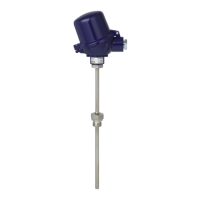3345267.08 06/2011 GB/D
22 WIKA operating instructions RTD and TC, intrinsically safe designs
GB
E) When using transmitters and digital displays, the following must be observed:
The contents of these operating instructions and those of the transmitter.
The relevant regulations for installation and use of electrical systems.
The regulations and directives regarding explosion protection. Transmitters and digital
displays must have their own approval.
F) When ordering spare parts, the parts that are to be replaced must be specied exactly:
■
Ignition protection type (here Ex i)
■
Approval No.
■
Order No.
■
Manufacturing No.
■
Order item
7.1.1 Special conditions of use (X conditions)
Versions with Ø <3 mm or "non-insulated" versions are operationally non-compliant with section
6.3.12 of EN/IEC 60079-11. Therefore, from a safety-relevant point of view, these intrinsically
safe circuits must be considered galvanically connected to the earth potential, which is why
equipotential bonding must be secured for the entire installation of the intrinsically safe circuits. In
addition, for the connection, separate conditions in accordance with EN/IEC 60079-14 must be
observed.
Electrostatic discharges must be avoided in instruments, that due to their design, do not conform
to the electrostatic requirements in accordance with EN/IEC 60079-0.
The transmitters and digital displays used must have their own EN/IEC approval. The installation
conditions, electrical connected loads, temperature classes or maximum surface temperatures
for use in potentially explosive dust atmospheres and permissible ambient temperatures can be
seen from the relevant approvals and must be observed.
Thermal backow from the process, that exceeds the permissible ambient temperature of
the transmitter, must not be allowed to occur. It must be prevented by installing suitable heat
insulation or a neck tube of suitable length.
If the wall thickness is below 1 mm, the instruments must not be subjected to ambient stresses
that may have an adverse eect on the partition wall. Alternatively, a thermowell of suitable
minimum wall thickness may be used.
When using a thermowell/neck tube, the overall instrument must be designed such that it
allows installation in a way that results in a suciently tight gap (IP 67) or a ameproof gap
(EN/IEC 60079-1) towards the less hazardous area.
The circuits of the coaxial element are operationally connected to one another. When applied in
practice a separate assessment must be made, or special conditions may have to be observed
when connecting the coaxial multipoint thermocouple. In addition, an assessment of the
intrinsically safe system (e.g. when connecting several sensor circuits of dierent transmitters to
one another) must be made.
7. Information on mounting, operation in hazardous areas (Europe)

